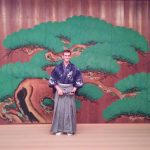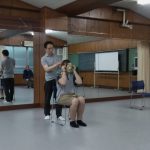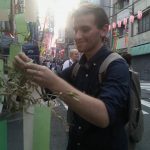Quinn Sipes
NOH Theatre
Tokyo, Japan
Summer 2017
I apologize for waiting a week to write one of these blogs but to be perfectly honest; I have been extremely tired after class to do anything, much less be witty on the web and write about the bad decisions I make while abroad. So, the past week has been a tough one. The pair of hakama that I bought turned out to be too small for me and I was out 40 dollars until someone in the class who did fit into them bought them off of me. My sensei also thinks that I am the best kotsozumi player in the men’s group, so guess what I get to do this coming Friday…that’s right; I get to lead the male group in playing the shoulder drum in front of an audience. Even better news is that I graduated from the Seiobo dance to the Takasago dance!
Here is a quick break down of the story for Takasago; Takasago is about a god who is a pine tree who disguises himself along with his lover as an elderly couple sweeping the pine needles around the pine tree that is his wife. The other main character; a Buddhist priest asks the old couple about the lover pine trees (two pine trees separated by a river who lean toward each other showing that they are in love with one another). The old man tells him the story of the two pine trees being gods and alludes to him and his wife being the two gods of the pine trees before disappearing. Takasago reappears in his true form as a young god and sings about the pine trees, his lover and everlasting love. I dance as Takasago in his true form, as a god. It is a quick dance, but there is a lot of singing which makes it kind of hard to perform, but I have picked it up relatively quickly and love this dance a whole lot more because there are quite a few stamps and it is a huge ego boost to be dancing as a young and powerful god.
I also have started memorizing a chant known as Gekkyuden, which I will perform on the main stage this coming Friday. It is a strong piece about long life and wishing the best for the emperor. Gekkyuden can be sung at weddings and it is considered very good luck if sung for the happy couple. If anybody would like this to be sung at their wedding, I am available for weddings and birthday parties…just email me, I charge 500 dollars for entertainment to be paid in cash up front…just kidding…but seriously, I am available.

I have been rehearsing really, hard and trying to memorize everything in a totally, different language. It has been really, really, rough and I have been able to do it, but it has come at the cost of me passing out at 8pm sharp every night. Later on in the week, I went yukata shopping and hakama shopping for my personal use. I found a yukata with a really, cool dragon pattern along with hakama that fit and complemented the color of the yukata, and a white obi which brings together the whole outfit. This yukata makes me look really intimidating and powerful when paired with the mask that Takasago wears for his dance in his true form.

The week flew by and before I knew it, it was Friday! As soon as class was over I went home took a nap and got ready to go to the gay district of Tokyo. Quick disclaimer; Legal drinking age in Japan is 20…I am/was 20 at the time I went out to the gay district. Needless to say I had a good time and I remember everything that happened, but I have to save some stories for my friends…let’s just say it was a night I won’t forget anytime soon, along with my classmates. We made it until 5 am when the trains started running again. As soon as i got home, I fell asleep and wasted my Saturday. On Sunday, I went to the Tanabata Festival.

The Tanabata Festival is known as the Chinese Star Festival.The Japanese adopted the myth and the festival into their own culture and it has become a big deal here. The Tanabata Festival celebrates the day that two stars are allowed to see each other. The story goes that there are two stars who are in love, but can never see each other because they live on opposite sides of a river known as the Milky Way. The gods decided that the two should be reunited on one day. So, on the seventh day of the seventh month the stars are allowed to cross the Milky Way to be with each other. The festival goes on to celebrate love and it is believed that during the festival you should write a wish and it will come true. Well, guess what I did at Tanabata…yup, I was selfish and wrote a wish down for myself…look, I have prayed for the world at a bunch of Shinto Shrines and Buddhist Temples, I thought it was time to look after myself now.
I am entering the last week of my class and I couldn’t be more excited. I am going through an emotional rollercoaster, because in this week I will say goodbye to some really, good friends that I have made here as they travel back to their respective countries, while I explore Tokyo and the rest of Japan for the following two weeks. But, I am also excited, because I can’t wait to perform on the Kita School’s main stage and make Professor Dubroff as well as Oshima Sensei, Nagashima Sensei, and the two Awaya Senseis proud with how much I was able to accomplish in only three weeks. To put this into perspective; most professional Noh actors have their debut on stage at the age of three with beginning their training around age two. I would also like to point out that I am twenty years old and I have been doing this for less than three weeks. Actually, pre-professionals training in Noh, train with the senseis for months on one aspect of Noh, focusing on one piece and it takes them about six months or so to make the same progress I made in three weeks. I have studied two dances, three chants, and one instrument…I just can’t believe how much progress I have made

I can’t wait to learn even more this week, but I don’t want it to end because I won’t know what I am going to do with all my new free time when the class is over.
Another side note; sitting seiza is still killing me and I don’t understand how people can do this for over an hour when a full length Noh play is being performed.